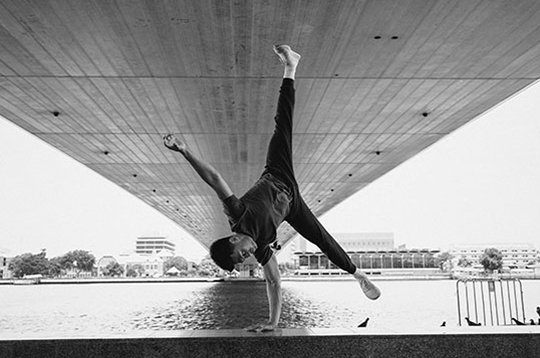Studio 13
Embody
Hella Wigge

This studio is available to students enrolled in ABPL90142 Studio C, ABPL90143 Studio D, and ABPL90115 Studio E.
Studio Description
In our modern world we have machines to transport us and do many of our chores; much of our time is spent largely disengaged from our physical environment. Yet as humans, we are embodied beings, our body is our instrument to experience and make sense of our world. Our body facilitates our experience of space, material and form and in turn allows us to be a more conscious creator. How finely tuned is your body?
Students will choose a form of practice that interests them, this could be something more active, like a particular form of dance or wrestling, or something more stationary, like playing the violin or calligraphy. Researching and experiencing this practice, students will generate a series of formal interpretations while devising their own brief and program for a small inner urban building which will facilitate the practice and celebration of their chosen modality.
Studio Outcomes
This studio seeks to empower students to explore ways to strengthen and document their bodily perception and experience, to test and refine different ways of translating.
How is the chosen modality celebrated in the sequence of spaces, the formal and spatial qualities, how is it expressed in the skin? As an inner urban intervention, how will the designer find ways to engage with and enrich the public realm?
While there will be a strong emphasis on using the body as an instrument to sense, to inspire and generate a body of work, students are free to meaningfully integrate digital processes. This studio will be particularly rewarding for students that are keen to strengthen their bodily perception and conceptual expression as well as furthering their particular interests in architecture.
Assessed components will be a carefully compiled journal documenting the studio process (interim & final), and the presentations (2 interims & final).
Studio Leader
Hella is an architect and artist, she has lived and practiced in Australia and Europe and has been teaching since 2006.
Her primary design principles are based on phenomenology; she is deeply passionate about the effect architecture has on the human body, mind and spirit, as well as upon the urban and greater environments. In relation to this studio, her more stationary practices are art, yoga and up-cycled fashion, more active ones include shiatsu therapy and Argentine Tango.
In her teaching she sets out to inspire her students to find their passion and voice in architecture.
Readings & References
- Aubin, C, Minguez Carrasco, C, 2019, Body Building, architecture and performance.
- Fox, M, 2016, Interactive Architecture, adaptive world.
- Holl, S. et al, 2007, Questions of Perception.
- Koren, L, 2008, Wabi-Sabi for artists, designers, poets & philosophers.
- Meerwein, G, Rodeck, B, Mahnke, F 2007, Color, Communication in architectural Space.
- Murray, A & Xing, R, 2018, Hand and Mind, conversations on architecture and the built world.
- Pallasmaa, J 2005, The Eyes of the Skin.
- Pallasmaa, J 2011, The Embodied Image.
- Pallasmaa, J 2009, The Thinking Hand.
- Plummer, H 1995, Light in Japanese Architecture.
- Plummer, H 2009, The Architecture of Natural Light.
- Tanizaki, J 1967, In Praise of Shadows.
- Terroir, 2019, Instruments.
- Terroir, 2019, Third Spaces.
- Zumthor, P 2006, Thinking Architecture.
- Zumthor, P 2006, Atmospheres.
- on Steven Holl, Lewis Arts complex, Princeton University:
https://youtu.be/NvZefjsRjf4 https://youtu.be/IPWidpzyx0I https://youtu.be/Vi7CPHY9KQM
Schedule Tuesdays and Fridays 18:15-21:15